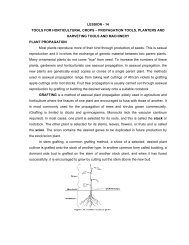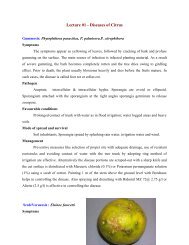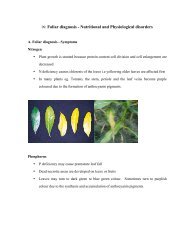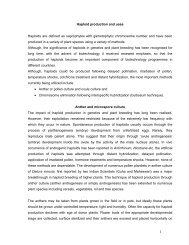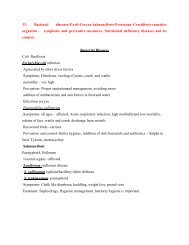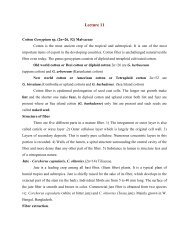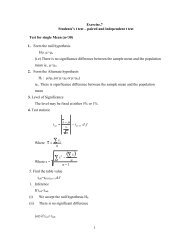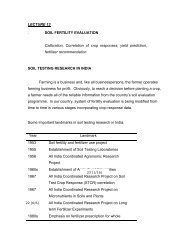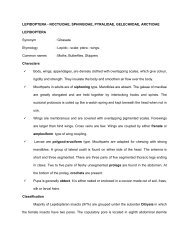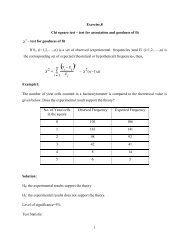5 - TNAU Agritech Portal
5 - TNAU Agritech Portal
5 - TNAU Agritech Portal
- No tags were found...
Create successful ePaper yourself
Turn your PDF publications into a flip-book with our unique Google optimized e-Paper software.
Better than othersCardamom Research Station, Kerala Agriculture University mentions that the (PGB-1) variety isblight disease resistant and moderately tolerant to thrips, stem borer, and other leaf diseases.The number of tillers is more and capsules less compared to the traditional Njallani variety.The success of (PGB-1) spurred Mr. Joy to continue research and the farmer developed across between (PGB-1) and a wild ginger variety and named it Panikulangara No 2.Good growthThe cross exhibited good growth and a common disease afflicting cardamom called azhkal(shoot rot) did not occur in this variety."Till date I have marketed about 23,000 seedlings of Panikulangara No 2," says the farmer.The Krishi Vigyan Kendra, Santhapara, Idduki and Prasar Bharti, All India Radio felicitated thefarmer for adopting modern agriculture techniques.For more details contact Mr. Joy Peter, Panikulangara, PO Vattiar, Kallar, Idukki Kerala, phone:04864278202, mobile: 9961812833.Date:05/08/2010 URL: http://www.thehindu.com/2010/08/05/stories/2010080561050500.htmJAIPUR: Chief Minister Ashok Gehlot flagged off nine mobile soil testing laboratories at PantKrishi Bhavan here on Wednesday to provide the facility of on-the-spot analysis of soil inagricultural fields in remote villages along with recommendation for the use of manure andfertilisers in correct proportion.The mobile labs, launched under the National Soil Health and Productivity Management Projectthrough public-private partnership, are expected to make a significant contribution to a bettercrop yield as well as remunerative prices for the agricultural produce.Addressing the gathering, Mr. Gehlot said: “The introduction of these laboratories is [a way of]paying gratitude to farmers who deserve respect like any other citizen.”
He called upon the farmers to adopt the latest techniques in their fields with the help ofagricultural scientists.Second green revolution“The time has come for the second green revolution in the country which will bring selfsufficiencyto the farmers. The first green revolution was the result of historic decisions taken by[the then] Prime Minister Indira Gandhi,” said Mr. Gehlot.The Chief Minister said the proposed law on right to food security would be brought into force in120 districts across the country under the public distribution system.“Farmers would play an important role in the implementation of the new legal right”, he added.Mr. Gehlot saw the interiors of mobile laboratories and handed over the agreement papers toseven private agencies running the labs. The vans with the lab facilities have been given toagencies from places such as Jaipur, Udaipur, Bikaner and Nawalgarh.Agriculture Minister Harjiram Burdak said technicians and agricultural experts travelling with thelabs would detect the nutritive elements in the soil and suggest use of appropriate fertilisers.Hesaid 14 permanent soil testing labs would be constructed in the State this year.Published: August 4, 2010 14:13 IST | Updated: August 4, 2010 14:13 IST Chandigarh, August4, 2010Area under guar unlikely to reach 3 lakh hectares in Haryana
The Hindu An agricultural scientist with the guar crop. Area under guar crop in Haryana isunlikely to reach targeted level of 3 lakh hectares this season due to shift in area by farmers toother crops. File PhotoArea under guar crop in Haryana is unlikely to reach targeted level of 3 lakh hectares thisseason due to shift in area by farmers to other crops like pulses, paddy and bajra.Traders said that fall in guar acreage may lead to firming up of guar seed and guar gum pricesin coming months.“We do not think the area under guar crop will reach 3 lakh hectares this season ... rather it(area) will restrict to 2.50 lakh hectares primarily due to shifting of area to other crops byfarmers,” Sirsa based Guar trader Prem Kandoi said on Wednesday.“Farmers prefer to sow bajra, pulses like moong and moth and even paddy for fetchingremunerative returns,” an expert pointed out.Haryana, which contributes 25 per cent of country’s guar output, had set a target to sow guarover 3 lakh hectares this season with estimated production of 3.60 lakh tonnes against 2.52lakh hectares brought last year.Sowing of guar crop starts in June end which goes till first week of August.
With decline in area under guar, prices of guar seed and guar gum are likely to soar in themonth of September, traders said. “There is a huge shortage of guar seed being witnessed inthe market which will cause increase in its prices,” a trader said.Against the current level of Rs 2,310 per quintal, experts estimate rates of guar seed to touch alevel of Rs 3,000 a quintal in September. “If there is no rain in September then the prices willfurther soar,” said a guar trader. The rate of guar gum is ruling at Rs 5,525 a quintal in spotmarket.Haryana, the second largest producer of guar seed after Rajasthan, sows guar mainly insouthern belt of the state including Sirsa, Hisar, Bhiwani, Rewari, Narnaul, Dadri and otherareas adjoining Rajasthan.Area under guar surged from 2.95 lakh hectares in 2006-07 to 3.41 lakh hectares in 2007-08.In 2008-09, it achieved record output of 6.02 lakh tonne with an area under cultivation of 3.71lakh hectares.However, in 2009-10, guar area shrunk to 2.52 lakh hectares with output of 3.29lakh tonne.Guar is a raw material to produce guar gum. Guar gum is used as a thickeningagent and additives in food products such as soups, sauces, milk and cheese products,processed meat products etc. It also has a use in textile, pharmaceutical and paper industry.© Copyright 2000 - 2009 The HinduThursday, Aug 05, 2010FCI may lower wheat lot size to bring small traders to spot exchangesDilip Kumar Jha / Mumbai August 5, 2010, 0:54 ISTUnfriendly policies and a lukewarm response to wheat sales through national spot exchangeshave forced the Food Corporation of India (FCI) to consider lowering the minimum stipulated
quantity to sell the commodity under the Open Market Sales Scheme (OMSS) to 10 tonnesfrom the current 100 tonnes. The move is aimed to attract participation from small traders.A source familiar with the development said: “The decision is almost finalised and will benotified soon.”FCI chairman Siraj Hussain, in a recent meeting with Business Standard, had hinted that thecorporation was liberalising warehousing policies to make them industry-friendly. The policy willbe liberalised to the Central Warehousing Corporation (CWC) standard, which is sufficient toattract participation from small traders.Currently, a minimum quantity of 100 tonnes is stipulated for selling wheat through spotexchanges under OMSS. But, the price fixed by the government is higher than the spot price.So, it is not economically viable for millers to buy wheat under OMSS.Financial Technology-promoted National Spot Exchange (NSEL) sold about 2,400 tonnes inthree auctions, while National Commodity and Derivatives Exchange-promoted NCDEX Spotcould not participate in the wheat tender.“The idea is to bring small flour millers, with a capacity to the tune of 10 tonnes, under the FCIsales scheme. Owing to their lower capacity, they have been barred from participating in OMSStenders. Through this approach, FCI will be able to sell more wheat and prices of processedwheat products, including flour, sooji (semolina) and maida (processed flour), may come downin the open market,” sources said.Early last month, NSEL had urged the corporation to consider lowering down the minimumstipulated quantity, so that small flour millers with a capacity of 10 tonnes could participate. FCI,however, allows lifting of a minimum three tonnes and maximum of nine tonnes from one depotat one point of time after showing their identity proof. But, if small flour millers want to lift morethan nine tonnes in one day from one location, they need to participate in tenders.In many cases, however, flour mills could not buy directly due to the absence of FCI godownsin the nearby location.“This is a welcome move”, said Anjani Sinha, managing director and CEO of NSEL, adding,
The crushing programme of the mills concerned would be monitored by a joint committee,including bank representatives, beside the loan utilisation. The 34 mills have agreed toamicably settle pending disputes with their labourers.Prakash Naiknavare, managing director of the Federation of Cooperative Sugar Factories ofMaharashtra, the largest sugar producer in the country, said sugar mills in the state werepoised to produce 8.65 million tonnes of new sugar, at an average recovery of 11.5 per cent.During 2009-10, mills crushed 61.44 mt cane to produce 7.1 mt of sugar.A monitoring committee under the chairmanship of the commissioner of sugar and comprisingmanaging directors of the Federation of Coops, the State Cooperative Bank and theVasantdada Sugar Institute would regularly review and analyse the field monitoring.Haryana paddy area likely to meet targetVikas Sharma / New Delhi/ Chandigarh August 05, 2010, 0:34 ISTDespite floods damaging considerable area under paddy in Haryana, agriculture department ishoping the area under paddy in Haryana is certain to reach the target.Haryana had set a target of 1,150,000 hectares under paddy this year, however the torrentialrains ensuing floods had resulted in damage of 270,000 hectare area posing a threat to thestate.Officials in Haryana agriculture department maintained, paddy area in Haryana had alreadycrossed 1,100,000 hectares and was expected to touch 1,130,000 hectares till August 4 as perrough estimates. However, final data was yet to be compiled.They added that in all probability the target area under paddy was likely to be met , eventhough it would fall short of last year-area of 1,205,000 hectares.The floods last month caused considerable damage to the paddy crop, in the state.Officials maintained timely steps had already been taken and farmers were advised to raise thepaddy nursery of short duration or Basmati varieties immediately and transplant it before thefirst week of August. Direct seeding of basmati variety is also being advocated to the farmers to
curtail the overall maturity period of the cropThe state government had made provisions for supplying seeds of Basmati varieties atsubsidised rate in the flood-affected areas.The agriculture department added, this year the area under basmati was anticipated to rise onaccount of floods. They said basmati area in Haryana could touch 65 per cent of the totalpaddy area as against 50 per cent area projected earlier.Farmers in districts of Sirsa, Fatehabad, Ambala, Kurukshetra, Kaithal and some parts ofKarnal who suffered losses to the crop on account of water deluging the fields, would opt forbasmati sowing leading to increase in the area under basmati.Select oil rises on firm global cuesPress Trust of India / New Delhi August 4, 2010, 15:01 ISTSelect edible oil prices rose by Rs 20 per quintal in the wholesale oils and oilseed market todayon buying by vanaspati units amid firming global trend.Elsewhere, edible and non-edible oil prices moved in a tight range on alternate bouts of tradingand settled around previous levels.Trading sentiment turned better after reports of palm oil climbed to the highest level in morethan four months in Malaysia.Marketmen said fresh buying by vanaspati millers and reports of firming global trend mainly ledto a rise in palmolein and crude palm oil prices.In the edible section, soyabean refined mill delivery (Indore) and soyabean degum (Delhi)
gained Rs 20 each to Rs 4,880 and Rs 4,620, while crude palm oil (ex-kandla) and palmolein(rbd) traded higher by the same margin at Rs 3,970 and Rs 4,670 per quintal.Following are today's quotations in Rs per quintal:Oilseeds: mustard seed 2,500-2,600 and groundnut seed 2,100-2,850Vanaspati ghee (15 litres tin) 750-860Edible oils:Groundnut mill delivery (Gujarat) 8,500, groundnut Solvent refined (per tin) 1,400-1,410,Mustard Expeller (Dadri) 5,300, Mustard Pakki ghani (per tin) 705-860, Mustard kachi ghani(per tin) 860-960Sunflower 6,300, Sesame mill delivery 5,900, soybean Refined mill delivery (Indore) 4,880Soyabean degum (Delhi) 4,620, Crude Palm Oil (Ex-kandla) 3,970Cottonseed mill delivery (Haryana) 4,500, Palmolein (RBD) 4,670, Rice bran (phy) 3,750 andCoconut (per tin) 1,050-1,080Non-edible oils:Linseed 4,100, Mahuwa 4,000, Castor 7,650-7,750, Neem 3,750-3,850, Rice bran 3,300-3,400and palm fatty 3,225-3,300Oilcakes: groundnut de-husk 800-850, sesame 950-1,150, Mustard (new) 1,025-1,050,Mustard 1,200-1,210 and Cottonseed 1,075-1,175Refined soya oil futures trade higher as demand risesPress Trust of India / New Delhi August 4, 2010, 12:25 ISTRefined soya oil futures moved up by Rs 2.05 to Rs 489.70 per 10 kg today largely on the backof pick up in demand in spot markets.At the Multi Commodity Exchange, refined soya oil for August month edged up by Rs 2.05, or0.42 per cent, to Rs 489.70 per 10 kg with an open interest of 613 lots.However, refined soya for September month held steady at Rs 493.60 per 10 kg in 184 lots.
Market analysts said pick up in demand in spot markets due to festive season led to rise inrefined soya oil prices at the futures market.Crude palm oil futures rise on spot demandPress Trust of India / August 04, 2010, 12:06 ISTCrude palm oil futures rose by Rs 3.50 to Rs 400.20 per 10 kg today as traders enlarged theirpositions tracking strong cues from spot market.At the Multi Commodity Exchange, crude palm oil for August month rose by Rs 3.50, or 0.88per cent, to Rs 400.20 per 10 kg with an open interest of 1,602 lots.Similarly, the oil for delivery in September month gained Rs 3.50, or 0.89 per cent, to Rs 397.50per 10 kg in 1,715 lots.Market analysts said traders enlarged their positions on expectations of pick up in demand inthe spot market in view of festive season mainly pushed up crude palm oil prices.Mentha oil futures up on spot demandPress Trust of India / New Delhi August 04, 2010, 12:03 ISTMentha oil futures rose marginally to Rs 713.30 per kg today as speculators created freshpositions after a pick up in demand in spot market.At the Multi Commodity Exchange, mentha oil for August month rose by Rs 0.30, or 0.04 percent, to Rs 713.30 per kg with an open interest of 4,853 lots.Similarly, the oil for delivery in September month traded higher by Rs 0.20, or 0.03 per cent, to
Rs 724.30 per kg with a business turnover of 3,548 lots.Marketmen said firming trend in spot markets on the back of pick up in demand helped menthaoil futures to trade slightly higher.Cardamom futures down 2.5% on sluggish demandPress Trust of India / New Delhi August 04, 2010, 12:01 ISTCardamom futures fell by Rs 29.70 to Rs 1,150 per kg today as traders reduced their positions,tracking weak cues from spot markets.At the Multi Commodity Exchange, cardamom for far-month October dropped by Rs 29.70, or2.52 per cent, to Rs 1,150 per kg with an open interest of 1,129 lots.Similarly, the spice for delivery in August month also fell by Rs 14.80, or 0.97 per cent, to Rs1,511 per kg in 1,540 lots.Marketmen said fall in demand and increased arrivals in physical markets led to fall incardamom prices at futures market.India's tea export dips 15% in JunePress Trust of India / New Delhi August 04, 2010, 15:57 ISTTea exports fell by around 15 per cent to 12.7 million kg in June this year due to dip inproduction in both northern and southern parts of India. During the same month last year, Indiahad exported 14.9 million kg of tea, the Tea Board said in statement.
The contribution of North India to the export basket fell to 4.9 million kg from 6.6 million kg inJune last year. South India also failed to match its last year's tally as exports slid to 7.8 millionkg from 8.3 million kg.Fall in exports is in line with dip in production during the month as a result of a massive 11.9million tonnes output fall in Assam. The North-Eastern state contributes more than half to thecountry's total annual production.Production in North India, mainly in Assam, fell due to heavy rainfall and pest attacks sinceFebruary this year.Industry sources said that the tea estates in Assam have also reported that production in Julyhas also been adversely impacted due to continuing heavy rains and the slow recovery ofestates from the severe Helopeltis pest attack.Registering a fall of 11.8 per cent, country's total tea production in June stood at 104 million kgagainst 118 million kg in the same month last year.Meanwhile, in the first six months of the current year, India's total tea exports declined to 83.9million kg against 74.5 million kg in the January-April period of the last year.The average price of Indian tea in the export market also fell to Rs 130.84 per kg in June thisyear compared to 142.46 a kg in the same month last year.India, the world's second largest producer and the biggest consumer of tea, accounts for about28 per cent of the global output and 14 per cent of the trade. There are about 1,600 tea estatesin India. The sector employs over two million people.India had exported 190 million kg of tea in 2008-09. The country exports CTC (crush-tear-curl)variety of tea mainly to Egypt, Pakistan and the UK and the premium orthodox variety of tea toIraq, Iran and Russia.India faces competition from Kenya and other African countries for exporting CTC tea, while fororthodox variety competition comes up from Sri Lanka and Indonesia.
Pepper, turmeric rise on stockists buyingPress Trust of India / New Delhi August 04, 2010, 16:25 ISTBlack pepper and turmeric prices rose by Rs 100 per quintal each in the national capital todayon increased buying by stockists as well as retailers amid tight stocks.Fall in supplies from producing regions also supported the rise in prices. Black pepper pricesrose by Rs 100 to settle at Rs 22,600 -22,800 per quintal.Turmeric prices also traded higher at Rs 16,600-19,700, against previous closing of Rs 16,500-19,600 per quintal.Traders said increased buying by stockists and retailers followed by pick up in domestic andexports demand pushed up pepper and turmeric prices in the wholesale markets here.Following are today's quotations (per quintal):Aiwain 14,000-19,000, black pepper common 22,600-22,800, betelnut (kg) 85-105, cardamombrown-Jhundiwali (kg) 830-840 and cardamom brown-Kanchicut (kg) 940-1050Cardamom small (kg): Chitridar 1,200-1,300, cardamom (colour robin) 1,380-1,400, cardamombold 1,430-1,440, cardamom extra (bold) 1,590-1,560 and cloves (kg) 320-400Chirounji (new) (kg) Rs 410-450 Dry mango( raipur) Rs 6,000-8,500 Dhania Rs 3,100-8,500Dry ginger Rs 22,000-25,500 Kalaunji Rs 10,000-11,800 Mace-Red (kg) Rs 1200-1400Mace-Yellow (kg) Rs 1500-1600 Methiseed Rs 3,200-4,200 Makhana (per kg) Rs 120-160Nutmeg Rs 520-550 Poppyseed (KG Turkey) Rs 200 Poppyseed (KG MP-RAJ) Rs 200-250Poppyseed (KG Kashmiri) Rs 180 Red chillies Rs 4,800-8,900Soya bari pariwar (20 kg) Rs 350-400 Saffron (kg) Irani Rs 1,15,000-1,25,000 Saffron (kg)Kashmiri Rs 1,55,000-1,65,000 Soanf-bold Rs 9,000-15,000 Turmeric Rs 16,600-19,700Tamarind Rs 2,250-2,600 Tamarind without seed Rs 3,800-5,500Tea (kg) Rs 60-175 Watermelon kernel (Kg) Rs 235 Jeera common Rs 14,200-14,500 Jeerabest Rs 15,300-15,800
Mixed trend in sugar pricesPress Trust of India / Mumbai August 04, 2010, 16:28 ISTSugar prices witnessed a mixed pattern of trading at the Vashi wholesale market here today.Medium sugar variety moved up on better demand from retailers amidst good stockists offtake.While small sugar continued to decline owing to stockists offering coupled with ample supplypositions.Medium sugar quality (M-30) rose by Rs 5/10 per quintal to Rs 2,560/2,655 from overnight'sclosing level of Rs 2,550/ 2,650.However, small sugar quality (S-30) fell by Rs 5/20 per quintal to Rs 2,530/2,580, as against Rs2,535/2,600 yesterday.Following are today's closing rates per quintal, with previous rates in brackets:Small sugar (S-30) quality Rs 2,530/2,580 (Rs 2,535/ 2,600) and Medium sugar (M-30) qualityRs 2,560/2,655 (Rs 2,550/2,650)Business Daily from THE HINDU group of publicationsThursday, August 05, 2010Date:05/08/2010 URL:http://www.thehindubusinessline.com/2010/08/05/stories/2010080552541800.htm‘Cartelisation' fails to sweeten sugar pricesMonthly release mechanism forces mills to sell at lower price.The very obligation to sell the quantities released to it for the month rules out the legalpossibility of hoarding by any mill (that some do manage to circumvent release orders is adifferent matter).
Harish DamodaranNew Delhi, Aug 4On July 22, sugar mills from Andhra Pradesh, Tamil Nadu, Karnataka, Maharashtra andGujarat met in Mumbai and “informally” decided not to sell below their production cost.Since the production cost was reckoned at an average Rs 2,700 a quintal, the mills agreedamong themselves to fix this as the floor rate for selling sugar.Though it was ostensibly a voluntary initiative not binding on any mill, the move drew flak. Theindustry was accused to resorting to “cartelisation” and “syndication”, with the Bombay SugarMerchants Association urging Government intervention to “stop such restrictive tradepractices”.How successful was this effort at “cartelisation”?The day after the July 22 meeting, ex-factory prices of S-30 sugar in Maharashtra rose by Rs
150-160 to touch Rs 2,640-2670 a quintal – close to the “agreed” Rs 2,700. They remainedaround these levels for five days.However by July 29, realisations had dropped to Rs 2,510-2,520 a quintal. Over the nextcouple of days, the prices plunged further to Rs 2,340-2,370 – below even the Rs 2,490-2,510levels prevailing on the day the mills apparently resolved not to incur cash losses by sellingbelow production cost.Monthly QuotaThere was a simple reason why cartelisation did not work and has probably failed in the past aswell. That has to do with the monthly release mechanism, under which every mill is allocated aparticular quota of sugar to sell in a given month.The very obligation to sell the quantities released to it for the month rules out the legalpossibility of hoarding by any mill (that some do manage to circumvent release orders is adifferent matter).“As long as the monthly release mechanism exists, there is no way we can cartelise. While wemay be able to hold back sales for a few days, at the end of the month there is no choice but todispose of the entire released quota. The traders know it and that is why they push theirpurchases to the extent possible to the month-end, when we have no option but to sell,”claimed a Maharashtra-based miller.Late purchasesWhile private mills largely follow the open outcry or price discovery route to sell their sugar,cooperative factories do not enjoy even this limited flexibility to decide on their quantum andtiming of sales.Maharashtra's Cooperative Societies Act requires mills to compulsorily float tenders for sale ofsugar. Factories typically divide their monthly release quota into four parts, which meansconducting weekly auctions, for which notices have to be published in local dailies.“Through this, the date of auction and quantities on offer are known; very often, traders do notparticipate in the auctions at the start of the month. They wait till the month-end to submit bulk
of their bids. It is they, not we, who cartelise,” the miller alleged.According to him, the opposition to sugar decontrol was mainly coming from traders andindustrial users, who have learnt to work the monthly release mechanism to their advantage.“When there is no such forcible sale dispensation for cement, steel or any other industry, whyshould sugar be treated differently? Cartelisation and restrictive trade practices in this casemust be dealt with the same law applying to all industries,” the miller added.Date:05/08/2010 URL:http://www.thehindubusinessline.com/2010/08/05/stories/2010080552900400.htmPranab defends Govt's efforts in curbing inflationLok Sabha adopts motion on price rise.Mr Pranab Mukherjee, Finance Minister (file photo).Our BueauNew Delhi, Aug 4The Lok Sabha on Wednesday adopted a motion on price rise and its impact and urged theGovernment to take further effective action to contain inflationary pressures.After a stout defence by the Union Finance Minister, Mr Pranab Mukherjee, on the various antiinflationarymeasures the Government undertook in the wake of price rise since last year, the
Lok Sabha Speaker, Ms Meira Kumar, said, “this House, having considered the inflationarypressure on the economy of the country, urges upon the Government to take further action tocontain its adverse impact on the common man.”Following a week-long impasse over the mode of debate on the motion a compromise wasstruck early this week and the House took up the issue on Tuesday with as many as 33members from all major parties taking part in the debate.Earlier, Mr Mukherjee, who is also the Leader of the House, reminded the members in his replythat “handling the inflationary pressure and taking corrective steps to lower the adverse impacton the people” were “the collective responsibility of the political leadership of all including theStates.” He said the public distribution system (PDS) and implementation of the EssentialCommodities Act (ECA) through de-hoarding drives and maintenance of essential supplies,were all with the State Governments.Mr Mukherjee made a strong case for bringing in the goods and services tax (GST) in order toavoid the cascading consequences of taxes on products, including petroleum products, andsought the cooperation of all. He said that was the reason why the Direct Taxes Code (DTC)was put on the public domain a year ago and feedback from major political parties wereincorporated.He said when the revised DTC draft would be brought to the House, it would be scrutinised bythe Standing Committee and would be debated by all. “Nothing can be done at the back of thisHouse,” he asserted.Referring to food-related inflationary pressures, Mr Mukherjee admitted that pulses and edibleoil remained in perpetual short supply and pointed out that even under the oil and pulsesmission, the country could not compass gains which it scored in the production of other grains.That was also the reason why a move to identify 60,000 pulses and edible oil villages wasmade in the Budget.He also stated that when the minimum support prices of major crops had been hiked year-afteryearin order to benefit farmers, there would be some inevitable “cost-push element” to theinflationary pressure.
Thorough reviewMr Mukherjee also pointed out that before putting in place universal PDS, the present state oftargeted PDS needs to be thoroughly reviewed and the Prime Minister has announced thesetting up of a sub-committee with the State Chief Ministers to revamp the PDS at the recentNDC meeting.On the Opposition charge that the Government was “insensitive” to the poor, Mr Mukherjeerebutted it saying that if that were so, “it would not have provided the rights backed by legalenactment, entitlement backed by legal enactment, whether it is in the case of jobs for thelandless rural poor people, entitlement of right to education at a cost of Rs 2,31,000 crore (theratio of sharing between the Centre and the States being 65:35).” He also reminded theOpposition that the Government has not changed the central issue price of the foodgrainspurported for PDS and asked whether this was not a reflection of its “sensitivity” to the poor.Later, the Leader of Opposition Ms Sushma Swaraj, said the Government could still reconsiderrollback of some recent price hike of essential commodities such as kerosene and LPG so as togive relief to the poor.geeyes@thehindu.co.inDate:05/08/2010 URL:http://www.thehindubusinessline.com/2010/08/05/stories/2010080551480800.htmWheat export window opensThe anticipated shortage in world wheat production and the current high prices open up awindow for India to explore wheat export possibilities.International wheat prices have rallied in recent days to touch 13-month highs in the wake ofaberrant weather in some of the major origins. While excessive wet weather has affectedplanting in Canada's Saskatchewan region and south-eastern Europe, prolonged periods of dry
weather and high temperatures in the Black Sea region have raised serious concerns aboutproduction prospects in Russia, Ukraine and Kazakhstan as well as north-western areas of EU.Taking note of the developments, the International Grains Council has reduced its forecast ofworld wheat production for 2010-11 to 651 million tonnes, trailing estimated world consumptionof 655 million tonnes. No wonder, milling wheat export quotations in the EU and the Black Seaport region have climbed by around $70 a tonne. The markets are also speculating aboutpossible export restrictions or even an outright ban by Russia and Ukraine. It looks like the rallyin wheat is not going to stop here and further price gains cannot be ruled out, especially withheightened speculative activity in the US bourses. India must step in to fill the void, at leastpartially.With this a window, albeit a small one, has opened for India to explore wheat exports. At 33.6million tonnes as of July 1, public stocks with the government (including buffer stocks andstrategic reserves) are far in excess of the prescribed minimum of 20 million tonnes. Whilestorage costs keep mounting month after month, some quantities of wheat stored in the openfor want of secured warehouse space are actually reported to be rotting. At current domesticcosts and prices, Indian wheat would be about Rs 15,000 a tonne or $320 a tonne free-onboard(FOB), which would still be uncompetitive by about 10 per cent.Will the government gather enough political will to encourage wheat export by providing a 10per cent subsidy? If export prices rise further and the disparity disappears, shipments to South-East Asian and North African countries may materialise on merit. Ongoing wheat imports intosouthern parts of the country should not be disturbed with tariff restrictions. There is a case forco-existence of import and export, on merit. At the same time, domestic consumers, especiallythe poor, should be well serviced through open market sales at affordable rates. New Delhimust keep the export option open and closely monitor overseas developments.Date:05/08/2010 URL:http://www.thehindubusinessline.com/2010/08/05/stories/2010080553071700.htmCrop hopes, panic sales drag pulses downOur Correspodent
Indore, Aug. 4The downtrend in pulses continued on Wednesday amidst hopes of bumper crops and panicselling by the traders.Chana dal in the spot market market quoted at Rs 2,600-2,675 a quintal, a drop of Rs 50.Masur dal witnessed a decline with its price in local mandi quoting at Rs 3,775-3,800 a quintalagainst Wednesday's Rs 3,825-3,850. With the arrival of new crop, moong dal is alsowitnessing a decline with prices plunging to Rs 6,100-6,200 a quintal, a fall of Rs 200.Tur dal (markewali) which was ruling at Rs 6,800 a quintal a few days ago, has slipped to Rs5,750- 5,800 a quintal, a fall of Rs 350 from the Tuesday's price.Amidst hopes of arrival of new crop by the month-end, the downtrend continued in urad dal aswell with prices in the spot market quoting at Rs 5,500-5,600. In view of declining demand forpulses in the market and panic selling by traders at the current level, pulse mills in MadhyaPradesh have lowered production by 35 per cent.According to the Madhya Pradesh Dal Mill Association President, Mr Suresh Agrawal, pulsemills are making use of only 65 per cent of their capacity. In the wake of continuous rains, theyare facing problems in drying up pulses. The other reasons which have prompted the millowners to lower their production are poor power supply and increasing crushing costs.Madhya Pradesh has a total of 700 pulse mills which have a combined capacity to produce7,000 tonnes a day. He said increase in coverage of pulse seeds has given the much-neededrelief to mill owners. This year total production of pulse seeds in Madhya Pradesh is expectedto be around 39 lt.Date:05/08/2010 URL:http://www.thehindubusinessline.com/2010/08/05/stories/2010080553021700.htmPoor offtake keeps turmeric staticOur CorrespondentErode, Aug. 4
Turmeric prices ruled stable at the Erode private turmeric market on Wednesday.After a four-day holiday, the market saw limited activity. Some buyers came to fulfil orders theyhad committed to earlier and opted to bid.The Finger variety sold at Rs 14,700-14800 a quintal,the root variety quoted at Rs 14600-14700 a quintal, unchanged from last week. Mr R.K.Viswanathan, a senior trader, said: “Virtually there is no upcountry demand and only one or twotraders have received orders and to fulfil these orders, they are buying the commodity. Thedemand in north Indian towns will increase only after August 15. Prices are expected to go upthen and also the sales will be encouraging.”Anticipating lower demand, the farmers are bringing only limited quantity of turmeric to themarket.Only 4,000 bags (of 75 kg each) of turmeric arrived at the private merchants associationmarket, Erode Cooperative Marketing Society and Gobichettipalayam Marketing society. Onlytwo or three bulk buyers purchased. The bought a total of 1,980 bags.Date:05/08/2010 URL:http://www.thehindubusinessline.com/2010/08/05/stories/2010080553051700.htmSugar displays mixed trendOur CorrespondentMumbai, Aug. 4A mixed trend was witnessed in sugar on Wednesday. Buying support from retailers was thinand demand was dull on the Vashi wholesale market.Spot prices fell by Rs 5-10 a quintal in S-grade sugar. But M-grade's price rose by Rs 10 onupcountry buying at mill level. At the local level, profit-taking resulted in decline of Rs 5-10 inNaka delivery rate. Mill tender rates were flat.Sugar mills continued selling at Rs 2,400-level a quintal and above. Trade volume in the marketwas at routine level.
On Tuesday evening 1.25 to 1.50 lakh bags (100 kg each) of S-grade and M-grade sugar weresold by Maharashtra's mills in the range of Rs 2,400 to Rs 2,490. Mills in and around Pune,Baramati, Satara, Karad, Kolhapur and Sangli were active sellers.There was talk of a railway rack (about 25,000 bags) of sugar being sold by a mill in Sangli to abuyer in Kolkata.Rajasthan and Madhya Pradesh traders purchased small quantities in the last two days. TamilNadu is buying from Karnataka because of the low cost compared with Maharashtra, said tradesources.Mills offered S-grade sugar at Rs 2,400-2,450 and M-grade at Rs 2,455-2,500 (includingexcise) for 100 kg. Wednesday's arrivals at Vashi were 40-43 truckloads (of 10 tonnes each)and lifting was at 38-42 truckloads.According to the Sugar Merchants Association, on Wednesday spot market rates for S-gradewas Rs 2,530-2,580 for 100 kg, (Rs 2,535-2,600) and for M-grade was Rs 2,560-2,655 (Rs2,550-2,650). Naka delivery rate for S-grade was Rs 2,490-2,510 against Rs 2,500-2,520. M-grade was at Rs 2,530-2,570 from Rs 2,535-2,580 for 100 kg.Date:05/08/2010 URL:http://www.thehindubusinessline.com/2010/08/05/stories/2010080553061700.htmShortage of palmolein for ready deliveryOur CorrespondentMumbai, Aug. 4Edible oil markets witnessed mixed trend on Wednesday. International markets were showingfirm trend. Malaysia's CPO futures rose nearly to a 5-month high on short covering, weakerringgit.Speculative selling pressure pulled NBOT soya futures down. In Mumbai market, soya oil
efined declined Rs 2 and rapeseed refined by Re 1. Sunflower expeller refined oil rose Rs 5 asalso cotton refined by Re 1 for 10 kg.Tight palmolein supplySupply position from port to refineries is very tight and that resulted in shortage of palmolein inmarket. Traders were expecting delivery from JNPT ports may be become normal but onWednesday evening, there was a talk that the weights and measurement department hasstarted checking some premises, which halted the whole routine / delivery / loading andunloading work at JNPT.Mumbai markets depend upon Liberty and Ruchi for supply of ready palmolein. Delivery fromthese two refineries has been halted since the last few days. Importers are quoting palmoleinfor August-end and September delivery, but not for immediate delivery. On ready basis,palmolein was traded between Rs 442 and Rs 445 with increased demand in resale. Volumewas very thin at about 150-200 tonnes, said a wholesale trader.Malaysian, NBOT ratesMalaysia's August crude palm oil futures ended higher by 29 ringgits (MYR) at 2,670 MYRagainst 2,641 MYR. September was higher by 33 MYR at 2,626 MYR (2,593 MYR) andOctober closed up by 28 MYR at 2,590 MYR (2,562 MYR) per tonne. Indore NBOT soya oilAugust futures closed lower at Rs 486.90 (Rs 487.70), and September futures at Rs 494.20.On the Mumbai commodity exchange, the spot rates were: groundnut oil Rs 850 (Rs 850), soyarefined oil Rs 475 (Rs 477), sunflower expeller refined Rs 470 (Rs 470), sunflower refined Rs535 (Rs 530), rapeseed refined Rs 576 (Rs 577) and rapeseed expeller Rs 546 (Rs 547),cotton refined Rs 495 (Rs 494) and palmolein Rs 444 (Rs 444) per 10 kg.Date:05/08/2010 URL:http://www.thehindubusinessline.com/2010/08/05/stories/2010080551781900.htmPepper futures dive on bearish sentiments
Total turnover increased by 4,149 tonnes. Total open interest dropped by 390 tonnes to 19,282tonnes.G.K. NairKochi, Aug. 4Pepper futures fell on bearish sentiments after witnessing high volatility and closed much belowthe previous close. Bearish reports from all the other origins quoting much lower were used bythe bear operators to pull the market down.Vietnam said to have exported 12,000 tonnes in July, while its shipments were said to be75,000 tonnes during January-June. These figures have created the apprehension that it mayhave more pepper in possession than what was being projected and that has created bearishsentiment in the market, market sources told Business Line.Meanwhile, Indonesia was offering Lumpong Asta at $3,950-$4,000 a tonne (f.o.b.) Kochi.While others such as Brazil, Sri Lanka were also offering lower against India's parity of $4,400-$4,450 a tonne. Add to this, weak operators who had bought pepper hoping the prices wouldshoot up suddenly, were liquidating as they could not hold on for long, trade sources said.Coorg Pepper was reportedly being offered at Rs 203-204 a kg anywhere in India and that alsoaided the price to drop, they said.However, on the spot there was no selling pressure as the growers and primary market sellerswere not ready to sell at lower rates, they said.August contract on the NCDEX fell by Rs 393 to close at Rs 19,268 a quintal. September andOctober dropped by Rs 378 and Rs 358, respectively, to close at Rs 19,497 and Rs 19,730 aquintal.Total turnover increased by 4,149 tonnes. Total open interest dropped by 390 tonnes to 19,282tonnes. August open interest fell by 514 tonnes while that of September and October moved upby 15 tonnes and 97 tonnes, respectively. Spot prices fell by Rs 300 in tandem with the futuresmarket trend to close at Rs 18,900 (ungarbled) and Rs 19,400 (MG 1) a quintal.
Date:05/08/2010 URL:http://www.thehindubusinessline.com/2010/08/05/stories/2010080553031700.htmLukewarm demand floors wheatKarnal, Aug. 4Lukewarm demand in the local market has brought down wheat prices by Rs 15 a quintal in thelast two days. The wheat market is witnessing a decline following reports that the FoodCorporation of India will offload its stocks in the market through the open market sale schemesoon. Wheat prices are at Rs 1,170 a quintal, the lowest in the recent past against Rs 1,210during the same season last year. On Wednesday, the Dara variety ruled between Rs 1,170and Rs 1,180 a quintal and fine variety at Rs 1,200 a quintal.On the other hand, desi wheat varieties witnessed a price rise. Tohfa variety of MadhyaPradesh ruled at Rs 2,200, Lokwan was quoted at Rs 1,810, kitchen queen new marka at Rs2,105, Angoor variety between Rs 2,120 and Rs 2,135 a quintal, Nano variety was quoted atRs 2,060 while the Kangan and Parle-G variety ruled at around Rs 2,175.Around 30 tonnes of the Dara variety arrived on Wednesday. Small millers and local traderspicked up the available stocks at Rs 1,180 a quintal against last year's Rs 1,210.Mr Subhash Chand, a wheat trader, told Business Line thatwith heavy fresh arrivals from UttarPradesh local stockists are also offloading their stocks in the market and there is not muchdemand in the market. Due to this, the wheat market is witnessing a declining trend, he said.He further said flour millers are waiting for the FCI's announcement on the open sale scheme.According to the flour millers, the FCI may not go for tenders and could fix prices as it deemsfit. But not going in for tenders is a good decision as there would be more transparency in thescheme, they said.Millers said that prices should be fixed taking into account the market situation as higher rateswould not be acceptable.Bloomberg reports: Wheat futures extended gains in Chicago on speculation Russia will restrict
exports after the worst drought in at least 50 years curbed production.Wheat for September delivery were at the high of the day, up 3.5 per cent at $7.04 a bushel inChicago.Prices have climbed 6.4 per cent this month, after rallying 38 per cent last month, themost since 1973. Milling wheat futures for November delivery in Paris climbed 2.9 per cent to€210.25 s ($278) a tonne.© Copyright 2000 - 2009 The Hindu Business LineSugar prices rise despite supply boost5 Aug 2010, 0259 hrs IST,ET BureauNEW DELHi: Sugar prices have started to recover despite efforts by the Centre to keep acheck on them. Prices had plunged by around Rs 200/q lastweek. In July-end, the industry had got together to boost ex-factory prices by 4% in orderto ‘protect’ production price, a move that on the very next day pushed up prices by Rs50/qtl. Since then, prices have recovered to gain by Rs 40/q across varieties.Traders have been maintaining that the industry decision would push up retail prices byaround Rs 3/kg even as food inflation remains high. Following this, the food ministry hadannounced the release of 19.2 l (including 17 l in free sale quota) of sugar for August. Theministry also refused extra time to the industry to sell its July quota of free sugar.In Delhi, sugar ready medium and second grade prices slipped by Rs 10 each onWednesday to settle atRs 2,890-2,990/q and Rs 2,880-2,980/q, respectively. Mill delivery medium and secondgrade price also eased by Rs 10 each to Rs 2,790-2,890/q andRs 2,780-2,880/q, respectively. The slide in price was sharply noticeable on August 2compared to earlier, when sugar millgate prices softened by Rs 20 per quintal in the
national capital following slackness in demand. In Mumbai markets too sugar pricesplunged markedly on Monday, with small sugar (S-30) quality ranging between Rs 2,540-2,625/qtl and medium sugar (M-30) quality ranging between Rs 2,590-2,670/qtl.In comparison, on July 26 after millers boosted prices, sugar ready medium and secondgrade prices rose by Rs 50 each (against previous closing prices) to Rs 2,900-2,950/q andRs 2,890-2,940/q, respectively. In Mumbai, mill delivery medium and second grade priceshad held steady at Rs 2,750-2,850 and Rs 2,740-2,840 per quintal, respectively.Traders had approached the farm ministry in order to seek intervention in stopping millersfrom ganging up to artificially hike the price of the essential commodity, a move which theydubbed an unfair trade practice.Ironically, the ministry decision to announce record sugar release in order keep prices oneven keel had come on the very day when minister Sharad Pawar initiated talks with theindustry on the contours of sectoral deregulation, expected to be implemented in the 2010-11 sugar season.Significantly, decontrol of the sector will mean that the Centre will give up its right toannouncing sugar release quotas for the industry, a crucial weapon used over the years todefuse high sugar prices. The industry believes—having projected sugar production at aminimum of 25mt for 2010-11—that this is the best time for marketing and sales decontrolof the sector, a view which the believe is shared by food minister Sharad Pawar. Sectoralmonitors believe that deregulation of the sugar sector will lead to increasing sugar retailprices. The sector is dominated to an extent by cooperative mills, especially in topproducer state Maharashtra, and decontrol is seen as likely to lead to rapid consolidationand shakeout over time allowing only the most efficient mills to survive.Tea export dips 15 per cent in JuneAug 2010, 1544 hrs IST,PTINEW DELHI: Tea exports fell by around 15 per cent to 12.7 million kg in June this year due to
dip in production in both northern and southern partsof India.During the same month last year, India had exported 14.9 million kg of tea, the Tea Board saidin statement.The contribution of North India to the export basket fell to 4.9 million kg from 6.6 million kg inJune last year. South India also failed to match its last year's tally as exports slid to 7.8 millionkg from 8.3 million kg.Fall in exports is in line with dip in production during the month as a result of a massive 11.9million tonnes output fall in Assam. The North-Eastern state contributes more than half to thecountry's total annual production.Production in North India, mainly in Assam, fell due to heavy rainfall and pest attacks sinceFebruary this year.Industry sources said that the tea estates in Assam have also reported that production in Julyhas also been adversely impacted due to continuing heavy rains and the slow recovery ofestates from the severe Helopeltis pest attack.Registering a fall of 11.8 per cent, country's total tea production in June stood at 104 million kgagainst 118 million kg in the same month last year.Meanwhile, in the first six months of the current year, India's total tea exports declined to 83.9million kg against 74.5 million kg in the January-April period of the last year.The average price of Indian tea in the export market also fell to Rs 130.84 per kg in June thisyear compared to 142.46 a kg in the same month last year.India, the world's second largest producer and the biggest consumer of tea, accounts for about28 per cent of the global output and 14 per cent of the trade. There are about 1,600 tea estatesin India. The sector employs over two million people.
India had exported 190 million kg of tea in 2008-09. The country exports CTC (crush-tear-curl)variety of tea mainly to Egypt, Pakistan and the UK and the premium orthodox variety of tea toIraq, Iran and Russia.India faces competition from Kenya and other African countries for exporting CTC tea, while fororthodox variety competition comes up from Sri Lanka and Indonesia.Thu,05 Aug 2010WeatherChennai - INDIAToday's WeatherCloudyThursday, Aug 5Max Min33.6 o | 27.0 oTomorrow's ForecastFriday, Aug 6Max MinRainy35 o | 27 oRain: 00 mm in 24hrs Sunrise: 05:54Humidity: 66% Sunset: 18:35Wind: Normal Barometer: 1004.0Extended Forecast for a weekSaturdaySundayMondayTuesdayWednesdayAug 7Aug 8Aug 9Aug 10Aug 1133 o | 27 o 33 o | 27 o 34 o | 27 o 34 o | 27 o 34 o | 27 oRainy Rainy Rainy Rainy Rainy



